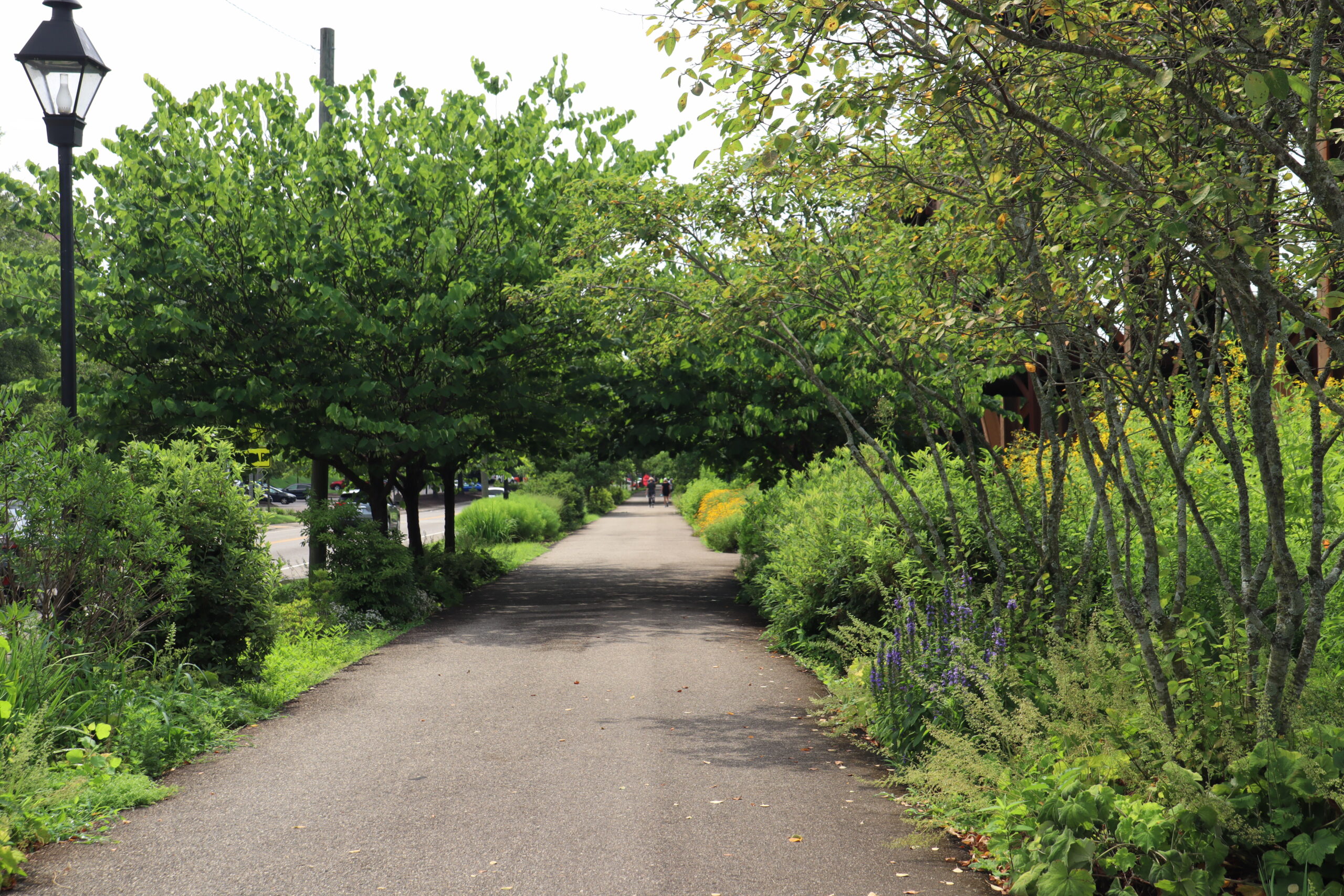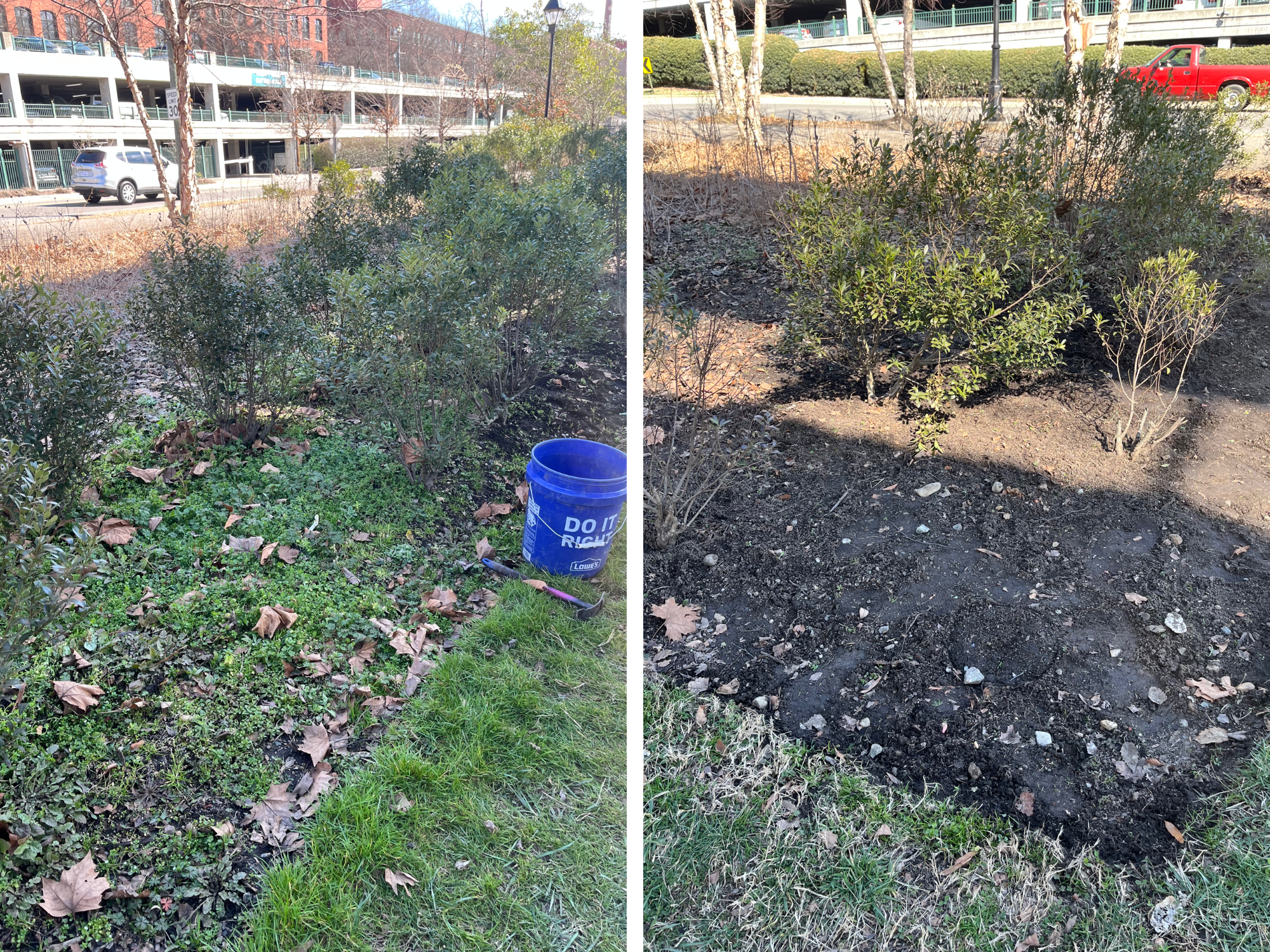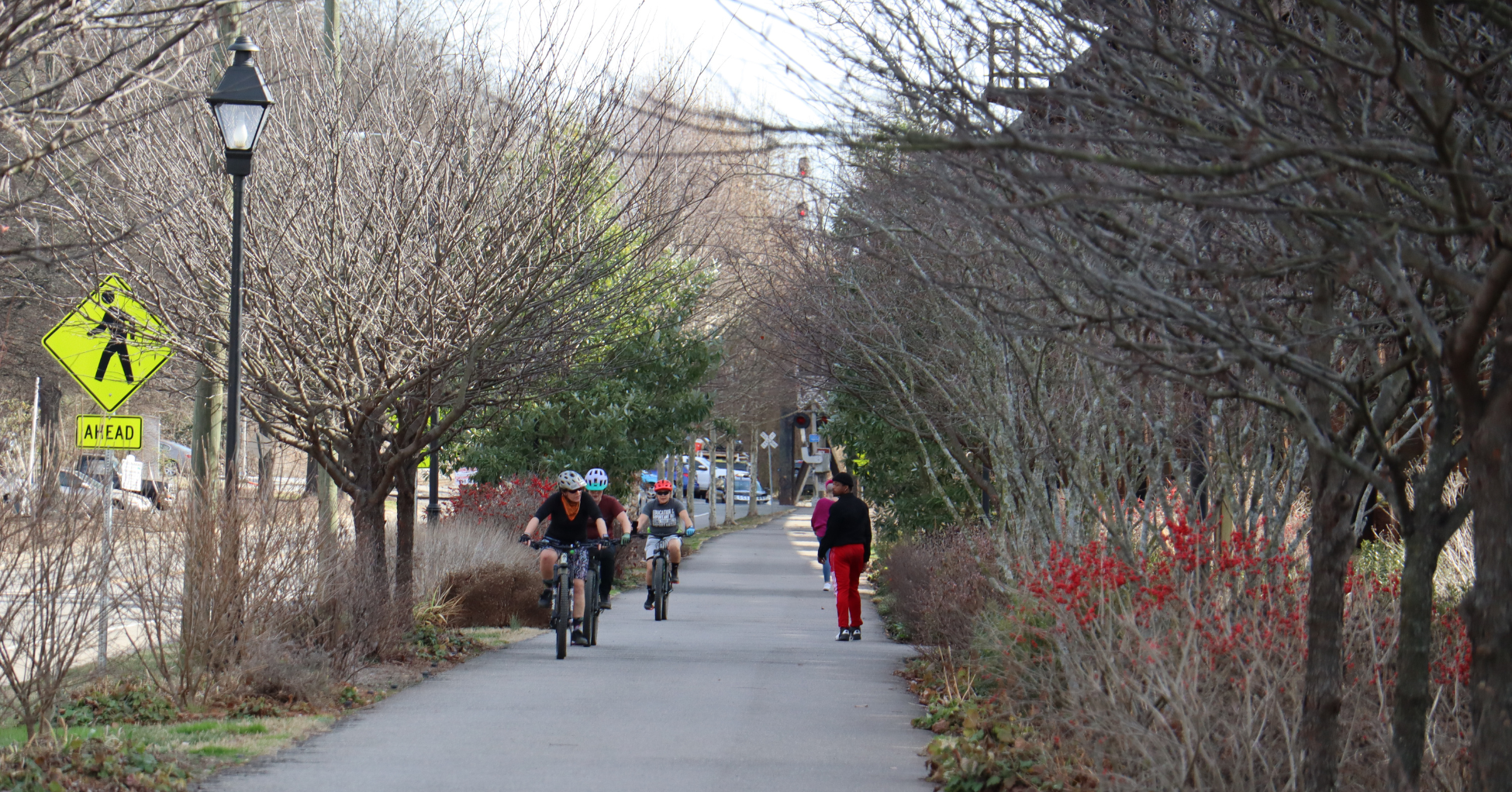February — The Fundamentals of Public Greenspaces
15 Years of Growth: Capital Trees and the Building Blocks of Great Greenspaces
Creating truly exceptional public greenspaces requires more than just planting a few trees. It demands careful consideration of every element that makes these places accessible, comfortable, and engaging for everyone. At Capital Trees, we’ve spent the last 15 years learning and growing, refining our approach to urban greening, and focusing on the fundamental components that transform ordinary spaces into vibrant community hubs.
The Essentials of Engaging Greenspaces
From the placement of a bench to the design of a trail — the details matter. We believe that well-designed greenspaces should offer opportunities for rest, movement, learning, and connection. Here’s how we incorporate these essential elements into our projects:

Benches between garden beds at the Low Line Gardens in Richmond, Virginia.
A Place to Pause: The Power of Seating
Seating is more than just a convenience; it’s an invitation to slow down, reflect, and engage with the surrounding environment. Well-placed benches, retaining walls that double as seating, and shaded resting spots create opportunities for respite and encourage social interaction. At the Low Line Gardens, the Virginia Capital Trail Foundation carefully positioned seating between garden beds along the pathway allowing visitors to fully appreciate the beauty of the native plantings and seasonal blooms. As this article from Strong Towns points out, ample seating is crucial for creating inclusive public spaces where people from all walks of life can relax and connect. We’ve prioritized seating at our recent projects at Canoe Run Park and the upcoming Hotchkiss Green. Seating will be added along the trail at the Hotchkiss Green and was placed in the newly developed pollinator garden at Canoe Run.

Footprints in snow on the recently installed walking trail at the in-progress Hotchkiss Green project in Richmond, Virginia’s Northside neighborhood.
Invitation to Explore: Walking Trails and Connectivity
Walking paths are the backbone of a successful greenspace. They encourage exercise, provide a connection to nature, and offer an opportunity for exploration. Well-maintained trails with smooth surfaces, gentle curves, and clear wayfinding make spaces more accessible and enjoyable for everyone. Neighborhood residents and Hotchkiss Field Community Center staff identified a walking trail as a priority during our community engagement process in the early planning stages for the Hotchkiss Green. They envisioned a place where visitors could walk, jog, stroll, roller skate, or cycle safely. Capital Trees chose to invest in a permeable asphalt surface at Hotchkiss for both its smooth surface and its stormwater management benefits (more to come on this in a future post!)

Patches of shade are provided by trees planted in the Low Line Gardens along the Virginia Capital Trail in Richmond, Virginia.
Cooling Relief: The Importance of Trees
Trees are essential to quality of life in an urban area. They provide shade, reduce heat, improve air quality, and enhance biodiversity. They’ve also been central to Capital Trees’ mission since our early days. In 2009, a presentation by then Richmond City Planner Rachel Flynn inspired our founders to envision a city with a thoughtfully designed tree canopy. This vision led to our first project on 14th Street, where we replaced traditional tree wells with bioretention systems to support tree health and manage stormwater runoff. Since then, trees have been a priority in all our projects, from the recent planting of 50 trees at Canoe Run Park, to the incorporation of over 50 trees in the plans for Hotchkiss Green, to our tree canopy and planting efforts with Henrico County parks and schools. Trees offer vital relief from the extreme summer heat, making our spaces inviting year-round while also supporting local wildlife.

Educational signage is installed at the Low Line Green in Richmond, Virginia to help visitors understand the importance of native plants and urban greenspaces.
Guiding and Educating: The Role of Signage
Signage plays a crucial role in helping visitors navigate, learn, and connect with a space. Interpretive signs at Capital Trees’ projects provide insights into native plants, sustainability efforts, and the history of the area. For example, the signage along the Low Line Gardens educates visitors about the importance of riparian buffers and ecological restoration, highlighting the environmental value of urban greenspaces.
Evolving Through Experience: 15 Years of Learning
Since our formation in 2010 thanks to a collaboration of our four founding garden clubs, Capital Trees has continually evolved. We’ve learned through our experience, working with public and private partners, to execute transformative projects that prioritize both environmental health and community well-being. Our dedicated volunteers, who contribute over 1,200 hours of their time annually, are a testament to our community’s commitment to creating and maintaining these vital public landscapes. As the article from UGREEN emphasizes, greenspaces act as social hubs, providing places for people to gather, interact, and build relationships. This understanding is at the heart of everything we do.
Looking to the Future: The Importance of Community
A thriving public greenspace is one where the community is actively engaged. We design the physical greenspaces to be engaging, but there’s more to it than that. Ongoing communication with the community and inviting folks to be involved are essential to fostering a sense of ownership and connection. We believe that community engagement is crucial throughout the entire process, from early project planning and design to installation and long-term care. Look out for next month’s post, where we’ll talk more about community engagement.
Well-designed public greenspaces enhance quality of life, foster community resilience, and promote environmental sustainability. By focusing on the foundational elements of seating, trails, shade, and signage, Capital Trees strives to create spaces that invite people to rest, move, learn, and connect. We’re committed to continuing our work, building on our 15 years of experience. We aim to enhance Richmond’s public realm and create welcoming environments that promote health, connectivity, and environmental sustainability.
Do you have a favorite feature of a greenspace? Let us know in the comments below! Join us for one of our Earth Day tours on Tuesday, April 22nd at 12:00 pm and 5:00 pm. Meet us at Great Shiplock Park (2803 Dock St, Richmond, VA 23223) for a one-hour walk through the gardens to experience the transformative power of well-designed public spaces firsthand.
Works Cited
Strong Towns. (2024, August 15). The Secret to a Better City: More Places to Sit. Retrieved from https://www.strongtowns.org/journal/2024/8/15/the-secret-to-a-better-city-more-places-to-sit
UGREEN. The Power of Green Spaces: How Parks and Public Spaces Promote Happiness and Health. Retrieved from https://ugreen.io/the-power-of-green-spaces-how-parks-and-public-spaces-promote-happiness-and-health/
February — Urban Greenspace Maintenance
Last month we discussed early winter gardening tasks. As we move into late winter, the “To-Do List” only continues to grow. Especially since the cold and snow have kept us out of the gardens.
As the temperatures warm, the cold season weeds will quickly jump onto the scene. Fortunately, we have enough experience in the Low Line Gardens to anticipate our trouble spots. For the last four years we have systematically worked on reducing the seed bank of winter weeds in the garden. This is accomplished by removing new weed plants before they can set and disperse seed. Because we’re in the gardens so consistently, we know exactly the areas where work is still to be done. The pictures below illustrate a before and after of the work done by volunteers on the 26th of February. The beautiful carpet of green is composed of chickweed, wild geranium, annual bluegrass, and bittercress. This is an area that we did not get to last winter before the plants set seed hence the proliferation of weeds we saw this season. Thanks to many hands at work the bulk of the interlopers was removed.

Before and after manual winter weed removal at the Low Line Gardens.
In the next few weeks we will start cutting back the shrubs, perennials, and grasses. With consistently warm temperatures the insects and bees that have overwintered in the garden will emerge and move on, allowing us to do some cutbacks without harming insect populations. We will also do some tree pruning before the trees leaf out. This pruning will involve removal of deadwood, crossing branches, and limbs that are impeding pedestrians, bike pathways, and lampposts.
Switching gears to a new project; we were very excited to see the Hotchkiss Green’s rain garden at Hotchkiss Field Community Center function exactly as intended. The snow and rainfall filled the garden to the brim, but over the course of several days it completely drained. With the rain garden being brand new the only maintenance required in the first year may be to touch up the mulch and do some light weeding.

The new rain garden at Hotchkiss Green working exactly as intended. It filled with rain, and slowly drained in the days thereafter.
Because of major ground disturbance during the construction of the walking trail at Hotchkiss, we expect a bumper crop of weeds. The seeds can lay dormant in the ground for years. When the soil is disturbed and the seeds are exposed to sunlight, they readily germinate. Happily, we already have several volunteer work days on the books for this spring.
On March 15th we have a community workday scheduled for the Low Line Gardens. If you are interested in participating, you can sign up through CFengage, linked here. These gardens thrive and endure only because of the many hours of work invested by the volunteers.
We appreciate all the different ways the community engages with us to bring our projects to fruition and keep them thriving for years to come. Please join us at the 15th Anniversary Celebration on March 20th to celebrate all our collective accomplishments.
Happy Gardening!
February— Featured Trees Seasonal Update

This black gum tree is planted in the median at Great Shiplock Park in Richmond, Virginia. Still largely dormant for the winter, if you look closely you can see the buds just starting to swell in advance of spring. The picture on the right offers a closer look at a bird’s nest from last year nestled amongst the branches, proof that wildlife seeks refuge in our urban greenspaces.
Throughout 2025, we’ll be documenting the black gum tree, Nyssa sylvatica, which is planted at many of our urban greenspaces. This native tree is one of our favorites, hence its wide use. It offers interest every season of the year — shiny green leaves in the summer, brilliant reds, yellows, oranges and purples in the fall, and architectural structure in the winter.
Important for our purposes, black gum trees thrive in a variety of growing conditions making it suitable for planting in urban soils. They are tolerant of drought, heat, and both dry and wet soils. Typically, in cultivated conditions, the tree matures at 20-30 feet in height with a 1-2′ diameter trunk. Because it’s native, it supports a variety of wildlife including mammals, birds, and insects.
Stay tuned over the next couple of months to watch the trees start to break dormancy. You can learn more about black gum trees here.
February — “Spotted At” the Hotchkiss Green

Recently installed trees and shrubs at our current project site: Hotchkiss Green
We experienced extremely cold temperatures and frozen soil conditions in January 2025 this year, putting a brief pause on the installation of landscaping at the in-the-works Hotchkiss Green in Richmond Virginia’s Northside neighborhood. But once the weather warmed up a bit at the end of January, we resumed planting. If you’ve stopped by the Hotchkiss Field Community Center in February, you may have spotted the new additions! Our crew installed more trees and shrubs, and applied mulch in the future pollinator garden, rain garden, and other beds. The trees and shrubs are still dormant right now, but in just a few weeks we’ll be seeing signs of spring in this space. Stay in the loop on Hotchkiss Green updates here.







 Join us for an outdoor Earth Day Celebration!
Join us for an outdoor Earth Day Celebration!






